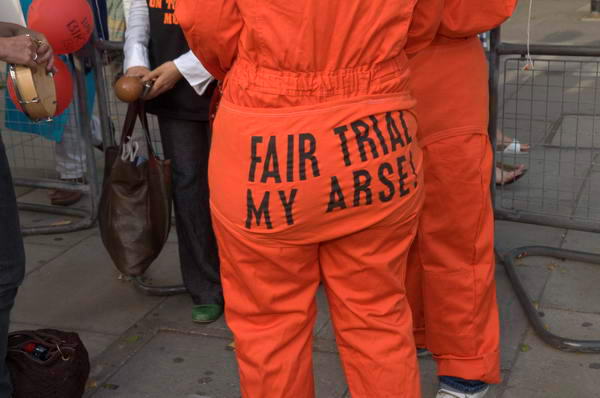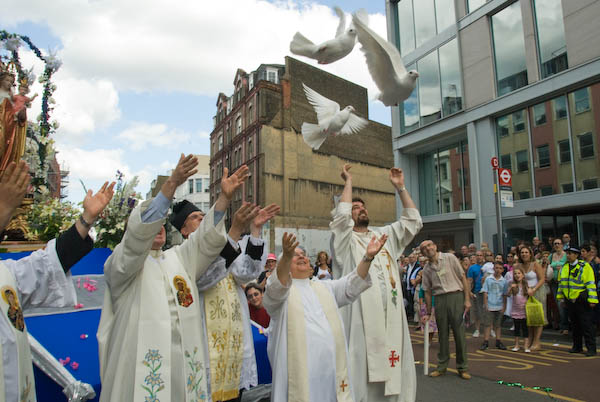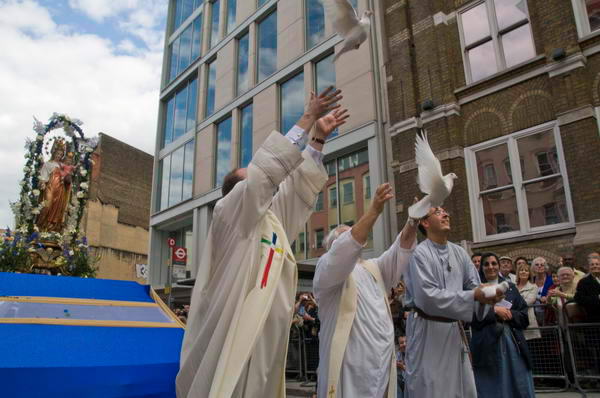There certainly were a host of pictures at the FOTO8 Summer Show 2008 in the Host Gallery in London’s Honduras St, EC1Y 0TH (23 July- 31 August 2008), with 164 images on the walls of the gallery and the adjoining stairs. Although it is perhaps admirable to be so inclusive, (and I was told there was a much larger than expected entry from around the world), I think it would have been a much better show, and certainly rather easier to view with perhaps half that number of prints.

Honduras St gets quite full
A simple listing with photographers names, sizes, media and prices was available at the gallery, but to fully appreciate the show you need a copy of the catalogue which contains the captions for the prints and can be downloaded as an illustrated pdf (4Mb) from the site. A rather smaller number of prints would have had the bonus of allowing captions to be included on the price list.
Most of the work was by photographers whose names were unfamiliar to me, although the three prints I personally singled out as possible choices for best of show were by photographers I know, including one I see regularly and another I’ve written about in the past. I won’t attempt to influence your efforts to find your own choice by naming them. Go along, look at the work and vote for your choice of best of show. Though I do think they have missed out in not calling it the Golden Daffodil Award.

The open bar was kept busy
Meeting another photographer from my generation (most of those present at the opening were considerably younger), I asked if she had anything in the show, and she told me that she didn’t have a great interest in competitions and hadn’t entered. I feel much the same, although in my case a general lack of organisation had also contributed to my not sending anything in. I have after all been a subscriber to FOTO8 magazine since it began, and did feel that perhaps I should support this initiative. But then I had other things to do. (If any of you reading this don’t get the magazine, do take a look at a recent issue – now better than ever.)
Competitions, particularly those based around single images (though a few photographers had two or three) do encourage and reward a particular type of photography, and much of what we were presented could be seen as a celebration of the exotic – unusual places, people and events – in a kind of colour supplement view of life. When my students used (rather often) to complain about having “nothing to photograph” and if only they could go to China or New York or Bosnia or wherever the last set of pictures they had seen in a magazine had been taken I used to remind them of something I think said by Alfred Steiglitz, to the effect that he had found his best photographs within 50 yards of his front gate. Though of course his family back yard at Lake George was also extremely extensive.
Or perhaps I might show them the work of Helen Levitt or Ruth Orkin (New York yes, but working on their not very unusual doorsteps) or many other photographers whose subject has been everyday life, not treated as the exotica so often on display in this show, but working with the warp and weft of everyday life and creating something with a little magic, some small epiphany. Of course you also see it in the best photojournalism, often working with much more dramatic events (and it is important that these should be photographed too.)

Pizza appeared and quickly disappeared
It’s work like this that, for me at least, is at the heart of photography, and perhaps the only game worth playing is trying to bring out the significance of the ordinary. There is work in this show that moved me in this way, perhaps even 20 or 30 pictures that I might want to live with and hang on my wall, but much of the rest, after I had stood looking at the image for perhaps thirty seconds on the gallery wall I didn’t really feel I wanted to look at it much longer or need to see it again. Plenty of novelty perhaps, but it isn’t easy to produce photographs you can live with. But 20 good prints is a good show, and one well worth a detour. Buses 55 and 243 stop handily and Old Street tube is a short walk away.
The show also prompted me to think about photographic printing, print sizes and pricing.
Pricing
Also on the show page at the Foto8 web site is a useful guide intended for the selected photographers about the pricing of their pictures, which others might also like to download for some sensible general advice on the subject. However I think there were perhaps rather too many who might have been given further advice on the subject.
Setting prices is always a problem. But I think many of these works are unlikely to find buyers at the kind of prices involved, unless the photographers have particularly rich and generous friends and relatives to support them as sometimes happens (mine are all poor and expect prints for nothing.) It would be nice to be proved wrong and to find that there are people willing to pay perhaps £500 or £750 or more for a work by a relatively unknown photographer.
Print sizes
As a very minor quibble, while I’m not in favour of uniformity in general, I think the gallery might have converted all sizes to centimetres rather than have some in metric and others imperial.
What I do find interesting is looking at the small images in the downloaded catalogue and comparing them with the works on show, which range from original small Polaroid prints to five-footers. One of the conclusions I drew from looking at the show was that printing large can be and usually is a mistake!
That all the pictures I found of most interest were a moderate size (mainly 16×20″ or 20×24″) in part reflects my interests stated above, but I did actually feel some of these were a little too large and might have been better at say 10×15″ or even smaller. But then I think photography is at its best as an intimate medium, perhaps in a book (although having spent more on my Eizo screen than the computer that serves it, I’m coming very much to appreciate the advantages of a high resolution rock-steady display screen for viewing my own work and other pictures available at suitable resolution – and certainly looking forward to a new generation of very much higher resolution screens in the future.)
Some works do need scale, but I’m not sure these were the ones actually printed big for this show – and there were a few small images that might have looked rather better at floor to ceiling size. What we are I think seeing in photography at the moment is size largely as a marketing device rather than an artistic one, relating more to the display space than the image. It’s an approach that has a great deal of sense. While large prints may – and I think did – look rather out of place on the crowded wall at HOST, the more normal photographic sizes would be lost on the vast white spaces of the corporate atrium.
Print Quality
Some of the best prints on the wall were inkjet prints, both black and white and colour. With prints for which no information on the print process (or an ambiguous term) it was seldom possible to decide whether they were inkjet or chemically processed.
Inkjet as a medium has certainly come of age (it did so a few years ago for colour, but black and white has now more or less caught up too), although this show also demonstrates that some of its users have still some way to go. Looking through the small digital thumbs in the catalogue there are clearly a dozen or two images on the wall where the print fails to do the work justice.
It isn’t too hard to set up a properly calibrated digital workflow that will produce excellent print quality on desktop printers such as the Epson R2400 – and, using appropriate paper and inks the results are likely to be more long-lasting than C-types or other chemical colour processes. But if you don’t have proper colour management or use unsuitable materials – such as Epson’s misleadingly named ‘Archival Matte’ then problems will arise.
Of course, back in the days when more of us went into the dark to print our own colour there were often some sorry examples of C-types on some exhibition walls – and of course many expensive lab prints from the 1970s and 80s boom in ‘New Color’ are now distinctly past their best.
Giclée
One thing I did find amusing is the number of different ways photographers choose to tell us (or, more often to disguise the fact) that their work is an inkjet print. Among the variations in this show (apparently produced on a device lacking an e acute) are: Giclee, archival Giclee, HP Professional, archival pigment, Giclee printed on Art photo paper, Giclee print on archival matt paper, Giclee art paper print, digital Giclee print (I wonder briefly about analogue Giclees, and how they might be made, but given its slang usage it’s best not pursue this train of thought far) while others give us the make of the printer, the paper, the day of the week and the name of their cat who sat next to their printer (well, almost.) I was pleased to see a few that simply said ‘inkjet print’ or ‘archival inkjet print.’ Giclee (or even giclée) is a term than should have long since been dead and buried.

Someone still working in an office round the corner as I went home








